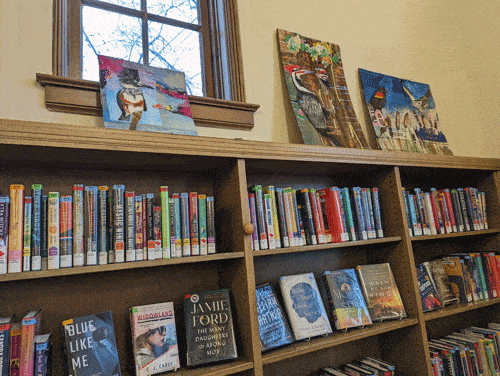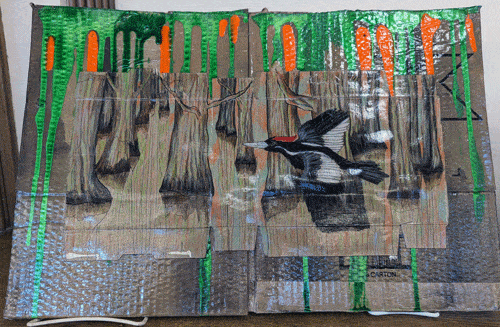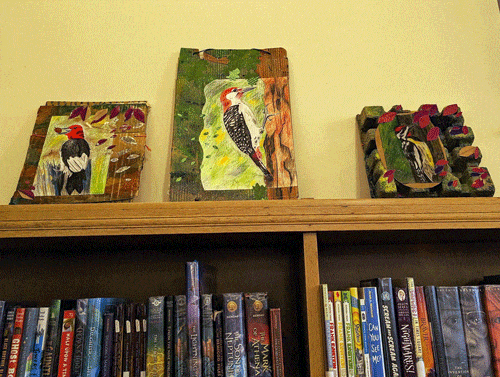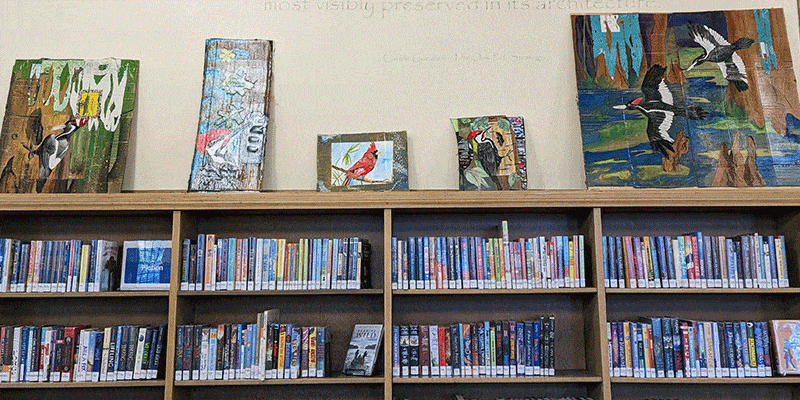By Kristen Romanowski, Staff Writer & Editor
Want to see some colorful birds during these dreary January days? Just look up.
Above the bookshelves at Maze Branch, that is, where artwork by outsider artist Casey Jones went up earlier this month.

Using recycled materials like packing boxes and paper, plus paint and glitter “and whatever I find in the basement,” Jones depicts birds commonly found in Cook County.
For example, red-winged blackbirds, a cardinal, a belted kingfisher, and several kinds of woodpeckers—from the more common red-bellied woodpecker to the more elusive and dramatic pileated woodpecker.
And then there are the ivory-billed woodpeckers.
“I am obsessed with ivory-billed woodpeckers,” Jones says.

‘They were so magical and are now most likely extinct’
Once an inhabitant of southeastern swamps and forests, the ivory-billed woodpecker is now possibly extinct (or close to it) in real life. But here at Maze Branch, members of the species soar above the shelves of children’s fiction.
“They were so magical and are now most likely extinct due to deforestation of the once magnificent tracts of hardwood forest in the United States,” Jones says.
And it’s not just the ivory-billed woodpeckers that have lost habitat. According to the National Audubon Society’s 2022 U.S. State of the Birds report, more than half of all bird species are in decline due to climate change and human activity. For example, the red-headed woodpecker, which Jones portrays with a berry in its beak, has lost half of its population in the last 50 years. Read the whole State of the Birds 2022 report (PDF) »

“Natural habitats continue to shrink,” Jones says. “Bird populations have decreased worldwide since 1970. I hope the ivory-bill will help viewers think about the importance of habitat preservation and environmental issues.”
Where an outsider artist goes to find inspiration outdoors
Jones says she considers herself an outsider artist because she has no formal training and is not an artist by profession.
Here, she explains more about how she makes art and where she finds inspiration.
When did you first start making art? How did (or how do) you teach yourself? I always liked drawing as a kid. I used to draw cartoons of my childhood cat. As an adult I watch a lot of DIY art projects and how-to watercolor videos on YouTube. I also like decoupage and cut paper art.
Who are some other artists you admire? I love and appreciate all folk art and outsider art. Great examples are Chicago artist Mr. Imagination and Georgia’s St. Eom of Pasaquan.
What materials do you use in your art? How do you get broken-down packing boxes to look so good? I use recycled boxes, recycled paper from consumer products, glue, pencils, watercolor paint, and glitter. And whatever I find in the basement. Boxes are flattened using a very high-tech method involving wax paper and old dictionaries.
How long does it take you to complete a piece? I’m not sure, art time exists in another dimension and may be impossible to measure.
Do you have a favorite bird or birds? If yes, why? The pileated woodpecker. They are stunning and have a funny laugh.
Do you have a favorite forest preserve to go watch birds? I like Palos a lot.
What do you hope people feel when they see your work? I hope viewers feel inspired to recycle creatively!
Anything else we should know? Never underestimate what cool things can be done using ordinary household materials.

